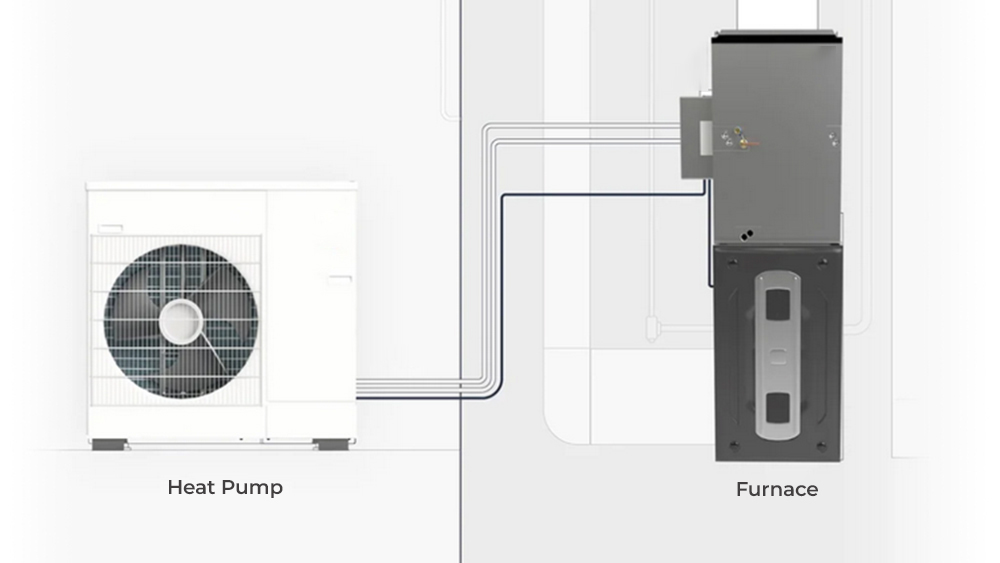
Key Takeaways
- A hybrid HVAC system combines an electric heat pump with a gas furnace for efficient heating in cold climates.
- This system is highly energy efficient and maintains a consistent indoor temperature.
- High installation costs are offset by long-term savings, fewer repairs, and tax incentives.
Furnaces have long been the go-to source for home heating, but with concerns about fuel costs and efficiency, homeowners are now considering electric heat pumps as an alternative. Not only are these systems more energy efficient, but they can both heat and cool your home, providing comfort all year round. One concern with heat pumps is that they may need to function better in colder temperatures, which can present a challenge for people who live in regions prone to freezing weather.
This is where the hybrid HVAC system comes in.
It combines the efficiency of a heat pump with the reliability of gas furnaces in extreme weather conditions. Together, these two units create a great pair to keep your home warm and cozy.
Let’s look in detail at how a hybrid HVAC system actually works, its pros and cons, and what are some of the best hybrid heating systems out there.
What Is a Hybrid HVAC System & How Does it Work?

A hybrid HVAC system, also known as a dual-fuel heating system, is a great option for keeping your home comfortable all year round. This type of heating system efficiently uses an electric heat pump and a gas furnace.
During mild spring and fall months, the heat pump powers on, stabilizing indoor temperature without the need for a gas furnace. It extracts heat from the outside and transfers it indoors. Even when you feel like it’s too cold outside, there’s still heat outside that can be pumped indoors. In ideal conditions, a heat pump can reach 300% to 400 % efficiency or even higher. Compared to that, a high-efficiency gas furnace is only 90% efficient.
As long as the outdoor temperature is above 35F, your heat pump can efficiently pull heat. However, below 35F, the heat pump starts struggling to achieve your desired home temperature. This is when the furnace takes over in a hybrid system. It uses natural gas or propane fuel to produce heat, which is then distributed throughout the building via a network of ducts.
Related: Heat Pump vs. Furnace: The Best Way to Heat Your Home
You can manually switch to a furnace, or you can invest in a smart thermostat that will make the change automatically. Some smart thermostats take into account outside weather conditions to decide if secondary heating is required and then switch to secondary heating automatically.
Related: What Is Auxiliary Heat? Explore Why Aux Heat on Thermostat Is Vital for Keeping You Warm!
Equip your HVAC system with smart features and achieve the perfect balance between comfort & savings.
Learn more
Is Dual Fuel Heating System Right for You?
Choosing the right HVAC system is a significant decision that can have a lasting impact on your comfort, savings, and property value. Consider the following key aspects before concluding.
-
Climate
Hybrid dual-fuel systems are perfect for regions that face fluctuating temperatures and extreme climate conditions, specifically the North and Northeast regions in the U.S. The winters in these parts are very cold, and summers are warm. The heat pump is utilized in mild temperatures, seamlessly switching to a furnace during extreme cold.
However, if you reside in moderate or hot climates, particularly in the southern US, where winters are mild, a dual-fuel system may not be necessary. In these cases, a heat pump alone can meet your needs.
-
Fuel Cost Analysis
Asses the available fuel options in your area and evaluate their market stability. If you live in an area with lower-priced natural gas and high electricity rates, a dual heating system may take longer to pay for itself. Consult a professional and ask them about factors such as local energy rates, including peak and off-peak electrical rates. This can help you calculate your potential savings and payback time.
-
Compatibility
If you’re considering upgrading to a dual-fuel heat pump, it’s important to consider the condition of your furnace. If you have an older furnace, it probably won’t work with a heat pump as a hybrid heating system. You will have to replace your furnace in this case, which can add a significant amount to the overall cost.
3 Best Hybrid Heating Systems for Your Home
For optimal hybrid heating solutions, consider exploring the following options:
1. Mitsubishi Electric intelli-HEAT Dual Fuel System
Mitsubishi Electric’s intelli-HEAT Dual Fuel System includes an exterior heat pump and an interior unit that is installed on your existing furnace. The system incorporates AI-enabled smart controls that intelligently switch from an electric heat pump to a gas furnace, allowing you to achieve complete indoor comfort in ambient temperatures as low as -11°F. It also features variable speed technology to reduce your fossil fuel usage.
2. Lennox XP25
Lennox XP25 offers efficient heating and cooling throughout the year. When paired with a Dave Lennox Signature® Collection furnace, it can swiftly switch between a heat pump and a furnace as the weather requires. This product has been designated as one of the efficient ENERGY STAR-certified products, which means it prevents greenhouse gas emissions.
3. Trane XL15c EarthWise® Hybrid Dual Fuel System
The Trane XL15c dual fuel heating system has a robust design that can handle any temperature request with ease. It seamlessly switches between a heat pump and a gas furnace, which means you can rely on it to keep your home comfortable, no matter the weather outside. It’s highly efficient and has ENERGY STAR certification to deliver exceptional performance without high energy bills.
How Much Does a Hybrid HVAC System Cost?
If you’re considering installing a dual-fuel HVAC system, you may be wondering what kind of price tag you’re looking at. According to Home Advisor, you can expect the total installation cost for a hybrid HVAC system to range from $2,500 to $10,000. The cost depends on whether you are adding a new system from scratch or you already have a furnace installed. The initial cost may seem daunting, but the added benefits eventually pay for themselves.
Pros & Cons of Hybrid HVAC Systems
Exploring the pros and cons of hybrid heating systems provides a complete grasp of their advantages and drawbacks.
Pro: Complete Heating Solution
When the heat pump’s efficiency declines during extreme climate conditions, the furnace kicks in to complement the heat pump and achieve your desired temperature. This setup ensures continual comfort regardless of the weather outside.
Pro: High Energy Efficiency
Electric heat pumps are more effective in milder to moderately cold weather, while gas furnaces are better suited for extreme temperatures. Combining both systems can be a smart choice for saving energy.
According to Aaron Green, owner of Essential Home & Garden, “Homeowners can expect annual fuel cost savings of $1,200 to $1,500 compared to traditional propane gas-only furnaces. This translates to an average yearly saving of 20-40% on energy costs.” How much you save depends on several factors, including the size of your home, your local climate, and how energy-efficient your home is overall.
Pro: Less Repairs
The heat pump and furnace complement each other quite well, resulting in less strain on either unit. This can ultimately lead to fewer repairs and replacements, saving you time and money in the long run.
Pro: Reduces Carbon Footprint
According to the Center for Climate Change and Solutions, the US residential sector accounts for 20% of the country’s carbon emissions. Switching to a dual-fuel system is a smart move for anyone who wants to lessen the environmental impact of burning fossil fuels.
With a dual fuel system, you will use your electric heat pump for the majority of the year and burn less gas for the furnace as a result. This setup can reduce the carbon footprint associated with natural gas heating by up to 30%. It’s an efficient solution that can save you money and help you to do your part for the environment.
Pro: Tax Incentives
Heat pump installation is eligible for a federal tax credit under the Inflation Reduction Act if you choose a model that achieves the highest tier of efficiency. This tax credit covers 30% of the total cost of your heat pump, including the cost of labor, up to a maximum of $2,000. It is available until the end of 2032.
Pro: High Life Expectancy
Dual-fuel heat pumps are known for their exceptional lifespan, ranging from 20 to 25 years. This is a significant improvement over traditional heat pump designs, which last around 15 years.
Pro: Backup Heating
Hybrid systems comprise two separate heating components. If one system malfunctions, the other will likely continue to function, guaranteeing uninterrupted heating capability.
Con: Costly Installation
One of the downsides of these systems is the steep initial cost. If you want to install a dual fuel system, you should be prepared to spend between $2,500 and $6,000 for existing pump retrofitting or $4,500 to $10,000 for a brand-new system. Although the cost might seem excessive, it is an investment that will pay off with reduced energy costs.
Con: High Maintenance
Optimizing the performance of hybrid heating systems entails the maintenance of two sets of components for both the furnace and the heat pump. In essence, this means that the number of components requiring regular upkeep is doubled.
In Conclusion
A hybrid dual-fuel HVAC system uses both the electric heat pump and the furnace to provide you with comfort and warmth as temperatures drop. If you live in an area with fluctuating temperatures and extremely cold winters, the hybrid HVAC system could be a smart investment for you. While the initial cost is quite high, the benefits undoubtedly outweigh the expenditure in the long run. During moderate temperatures, the heat pump is all you need to maintain an ideal home climate, while furnace only runs in frigid weather. This helps to reduce energy consumption and save you money on your heating bills.








